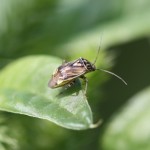 As our earliest cotton is beginning to square, below are a few bullet points to remember. We need to be especially alert considering the unusual season we have had thus far. There almost certainly has been an extra generation of tarnished plant bugs give the early spring we had this year.
As our earliest cotton is beginning to square, below are a few bullet points to remember. We need to be especially alert considering the unusual season we have had thus far. There almost certainly has been an extra generation of tarnished plant bugs give the early spring we had this year.
- Initially, the heaviest tarnished plant bug infestations are often concentrated in the first squaring fields … these fields have more food and are more attractive.
- Treatment is recommended during the first two weeks of squaring when an average 8 or more plant bugs are found per 100 sweeps, or anytime square retention is less than 80% and plant bugs are present.
- The neonicotinoid insecticides (Centric or one of the imidacloprid products) are typically recommended prior to flower. Carbine is another option. Frankly, Centric at 1.75 – 2 oz/acre is the “go to” treatment when populations are well above threshold in preflowering cotton. However, imidacloprid, Intruder and Carbine have a fit. Intruder and Carbine are excellent choices if aphids are an issue. Imidacloprid is an economical choice. I had good reports last year from people mixing 1 oz of Centric with full rates of imidacloprid (Admire Pro, Couraze, Wrangler, etc.). The combination may be cheaper than 2 oz of Centric. There are many imidacloprid products including 1.6, 2.0, 4.0 and 4.44 lb formulations. Make sure to use the correct rate depending upon the formulation of the product.
- Avoid the use of pyrethroid (or premixes containing a pyrethroid) and OP insecticides such as Orthene, Bidrin or Dimethoate from first square to first flower. These products have more value and a better fit later in the season. Using pyrethroids now will make them less effective during crunch time. The pyrethroids and acephate are also infamous for creating aphid and spider mite problems.
- Automatic applications are discouraged. In a typical year, many fields will not require an application for plant bug field prior to flowering. Some fields may require several. Sampling is best and proven approach to making treatment decisions. Scheduled sprays are often poorly timed, result in extra sprays, lead to resistance, and create secondary pest problems.
By the way: The Bidrin label has changed and allows the use of up to 3.2 oz of product up to first bloom. Previously, no Bidrin could be used from first square to first flower. However, you are NOT allowed to apply more than a total of 3.2 oz of Bidrin from emergence to first flower. So if you used Bidrin for thrips control, you’ve likley used up your quota. Regardless, this low rate has little value for us. It was mostly added in for fleahopper control in Texas.


Please comment on the most effective way to use Diamond for TPB control.
Richard,
Bill refers you to an article that sums it up pretty well. You will hear a lot about using Diamond the third week of squaring in more southern delta environments. However, my data suggests this approach does not work as well in TN. They tend to have have adult movement and nymphal establishment during this time. That is less true for us. Our big nymph blow up tends to be 10-14 days after first bloom. Getting Diamond out just before this time is a good option. There is some downside if you go too early. Diamond will flare mites and aphids similar to pyrethriods. Frankly, these negative effects are less obvious in high spray environments because there are no beneficials left. Also, the southern delta’s hand is forced because their resistance to other chemistries is worse than ours. Diamond is a good product and we need to use some. I just think it typically has a better fit for us as the first spray in blooming cotton. It will need a tank mix if stink bugs are present in significant numbers.
https://news.utcrops.com/2011/06/more-on-plant-bugs-as-the-action-continues/
Good article from Scott last July. Just an FYI. Mentions Diamond and use strategy for this product.